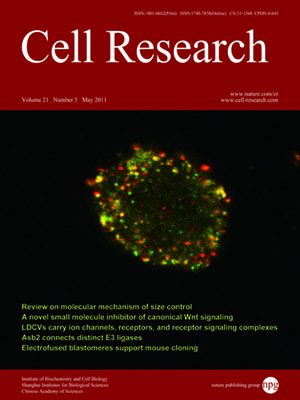
Volume 21, No 5, May 2011
ISSN: 1001-0602
EISSN: 1748-7838 2018
impact factor 17.848*
(Clarivate Analytics, 2019)
Volume 21 Issue 5, May 2011: 730-740
ORIGINAL ARTICLES
A diterpenoid derivative 15-oxospiramilactone inhibits Wnt/β-catenin signaling and colon cancer cell tumorigenesis
Wei Wang1, Haiyang Liu2, Sheng Wang1, Xiaojiang Hao2 and Lin Li1
1State Key Laboratory of Molecular Biology, Institute of Biochemistry and Cell Biology, Shanghai Institutes for Biological Sciences, Chinese Academy of Sciences, Shanghai 200031, China
2State Key Laboratory of Phytochemistry and Plant Resources in West China, Kunming Institute of Botany, Chinese Academy of Sciences, Kunming 650204, China
Correspondence: Lin Li, Xiaojiang Hao,(lli@sibs.ac.cn; haoxj@mail.kib.ac.cn)
The Wnt/β-catenin signaling pathway is a highly conserved pathway in organism evolution and regulates many biological processes. Aberrant activation of the Wnt/β-catenin signaling pathway is closely related to tumorigenesis. In order to identify potent small molecules to treat the over-activated Wnt signaling-mediated cancer, such as colon cancer, we established a mammalian cell line-based reporter gene screening system. The screen revealed a diterpenoid derivative, 15-oxospiramilactone (NC043) that inhibits Wnt3a or LiCl-stimulated Top-flash reporter activity in HEK293T cells and growth of colon cancer cells, SW480 and Caco-2. Treatment of SW480 cells with NC043 led to decreases in the mRNA and/or protein expression of Wnt target genes
Axin2, Cyclin D1 and
Survivin , as well as decreases in the protein levels of
Cdc25c and
Cdc2. NC043 did not affect the cytosol-nuclear distribution and protein level of soluble β-catenin, but decreased β-catenin/TCF4 association in SW480 cells. Moreover, NC043 inhibited anchorage-independent growth and xenograft tumorigenesis of SW480 cells. Collectively these results demonstrate that NC043 is a novel small molecule that inhibits canonical Wnt signaling downstream of β-catenin stability and may be a potential compound for treating colorectal cancer.
Cell Research (2011) 21:730-740. doi:10.1038/cr.2011.30; published online 15 February 2011
FULL TEXT | PDF
Browse 2377


